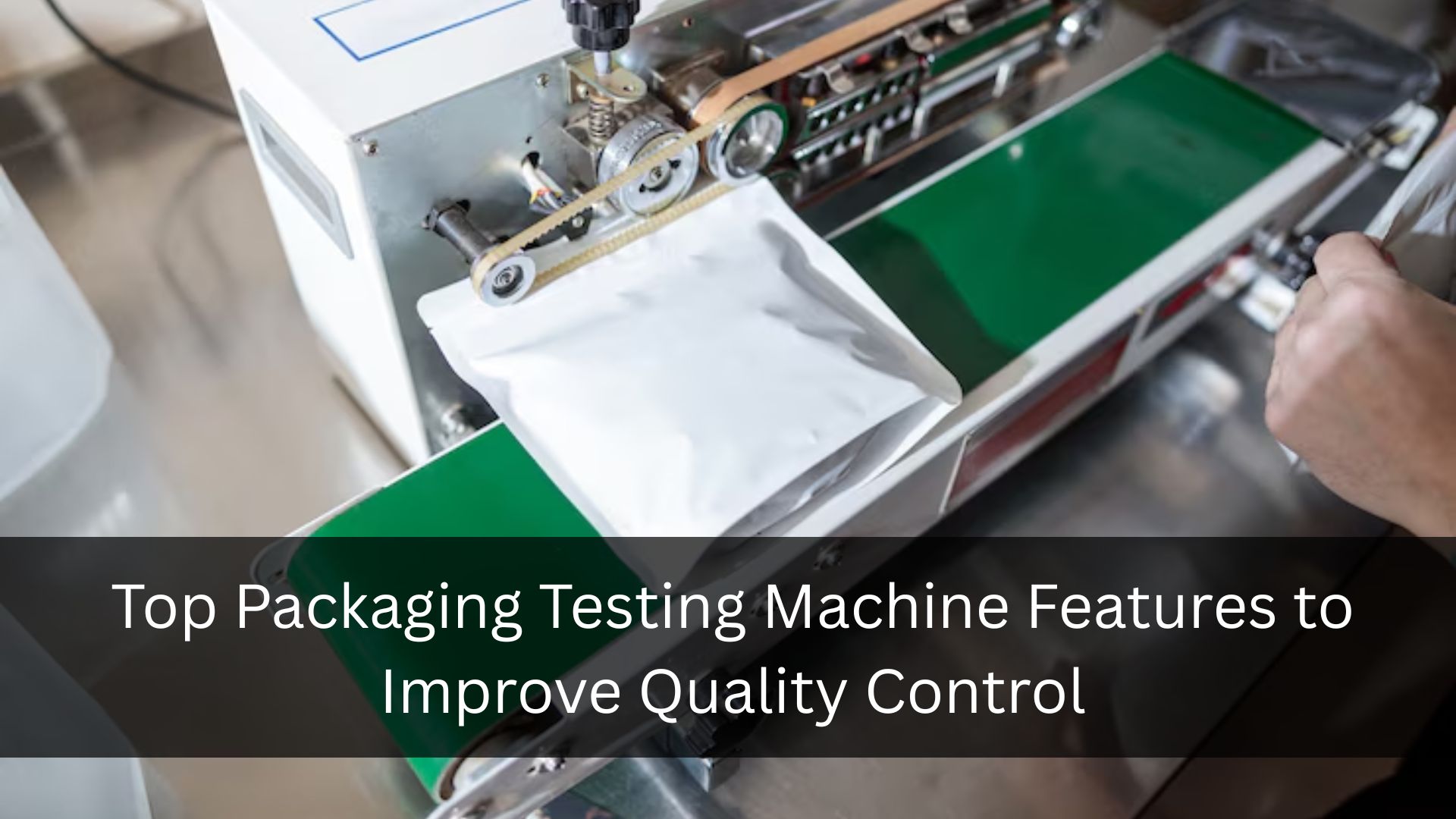The Importance of a Packaging Testing Machine in Quality Control
Before we dive into the specific features, it’s important to understand the value a Packaging Testing Machine brings to quality assurance. Packaging doesn’t just protect a product—it influences shelf life, user experience, transportation safety, and even brand perception. If a package fails in real-world conditions, the result could be product returns, compliance issues, or damage to a company’s reputation.
A Packaging Testing Machine helps mitigate these risks by enabling detailed evaluation of material strength, package integrity, and performance under simulated stress conditions. These tests provide the data needed to make informed design changes and material choices that improve overall product quality.
Compression Testing Feature in a Packaging Testing Machine
One of the most essential features of a Packaging Testing Machine is compression testing. This function assesses how much pressure a package can endure before it starts to deform or collapse. It’s especially critical for packages that are stacked during shipping or storage.
Compression testing ensures that boxes won’t give in under pressure, protecting the contents within. By integrating this feature into quality control routines, businesses can avoid product damage due to crushing and improve the structural reliability of their packaging solutions.
Drop Testing Feature in a Packaging Testing Machine
Drop testing simulates the effects of accidental falls during handling and transit. A Packaging Testing Machine equipped with drop testing functionality can replicate various drop heights and angles to test how well a package absorbs impact.
This feature is crucial for fragile or high-value items like electronics, glassware, and cosmetics. By evaluating the effectiveness of protective materials like foam inserts or air cushions, businesses can make data-backed decisions that reduce breakage and returns.
Vibration Testing Capability of a Packaging Testing Machine
During transportation, packages are subjected to continuous vibrations, especially on long road, rail, or sea journeys. A Packaging Testing Machine that includes vibration testing simulates these conditions to assess how well the packaging can withstand prolonged shaking.
Vibration testing reveals issues such as internal shifting, seal weakening, or wear and tear on structural components. It’s particularly useful for ensuring product stability in e-commerce packaging, where multiple handlings and long delivery routes are common.
Burst Strength Testing on a Packaging Testing Machine
Another critical quality control feature of a Packaging Testing Machine is burst strength testing. This evaluates the maximum internal pressure a package can withstand before rupturing. It’s especially relevant for sealed containers, pouches, and vacuum packaging.
Burst testing helps manufacturers ensure that their packaging will not fail due to internal pressure changes during transit or storage. This feature supports product safety and reduces liability in sectors such as pharmaceuticals, chemicals, and food.
Tensile and Peel Testing in a Packaging Testing Machine
Flexible packaging materials, such as plastic films, foils, and laminates, need to maintain strength and cohesion during production and usage. A Packaging Testing Machine with tensile and peel testing measures the force required to pull a material apart or separate seals.
This feature is essential for validating the durability of seals, adhesives, and bonding layers. It ensures that packages remain sealed until opened by the end user, helping preserve product integrity and hygiene—particularly for perishable or sensitive products.
Environmental Simulation Capabilities in a Packaging Testing Machine
Some Packaging Testing Machines come equipped with environmental chambers that simulate temperature, humidity, and atmospheric pressure variations. These conditions can dramatically affect the performance of packaging materials.
For instance, high humidity may weaken adhesives, while extreme cold could make plastics brittle. This feature allows manufacturers to assess packaging durability under different climate scenarios, supporting better decisions for international shipping and long-term storage.
Real-Time Data Collection and Analysis in a Packaging Testing Machine
Modern Packaging Testing Machines offer integrated digital systems that collect real-time data during each test. These systems provide analytics on material performance, deviations from standards, and compliance metrics.
Real-time data not only speeds up the testing process but also ensures higher accuracy and consistency. Engineers and quality control managers can instantly identify problem areas and make improvements, leading to faster production cycles and reduced wastage.
Automation Features in a Packaging Testing Machine
Automation is transforming quality control across industries, and packaging is no exception. A Packaging Testing Machine with automation features can run multiple tests with minimal human intervention, reducing labor costs and operator errors.
Automated systems are capable of running overnight or in batch modes, significantly increasing testing efficiency. They also allow for repeatable and standardized testing, which is crucial for compliance with international quality standards like ASTM, ISTA, and ISO.
Versatility and Multi-Test Capability in a Packaging Testing Machine
One of the most valuable features of a Packaging Testing Machine is its versatility. Instead of investing in separate equipment for drop, vibration, or burst tests, companies can use a multi-functional machine that handles all of these assessments.
This consolidated approach saves space, reduces capital expenditure, and improves workflow efficiency. It also makes it easier to compare results across various tests, giving a more holistic view of a package’s performance.
User-Friendly Interface and Software Integration in a Packaging Testing Machine
A powerful Packaging Testing Machine is only as effective as its ease of use. Machines with intuitive user interfaces, touchscreen panels, and software integration make it easier for technicians and engineers to operate them with minimal training.
Software features like automated reporting, cloud data storage, and remote monitoring streamline documentation and improve transparency in the quality control process. This is especially important for companies needing to present audit trails or meet regulatory requirements.
Compliance Support with a Packaging Testing Machine
Global supply chains require compliance with international packaging standards. A Packaging Testing Machine helps companies meet these standards by offering pre-set test protocols that align with regulations such as ISTA (International Safe Transit Association) and ASTM (American Society for Testing and Materials).
By using machines that support these protocols, companies can confidently ship products globally without worrying about packaging failures that result from non-compliance.
How a Packaging Testing Machine Supports Continuous Improvement
Continuous improvement is at the core of quality control. A Packaging Testing Machine provides valuable insights that can be used not just to validate current packaging, but also to enhance future designs. It enables data-driven decisions that lead to better materials, improved structures, and more cost-effective solutions.
This ongoing optimization process improves packaging performance over time, reduces product damage, enhances customer satisfaction, and supports sustainable business growth.
Conclusion: Investing in a Packaging Testing Machine to Elevate Quality Control
In an era where quality, efficiency, and customer satisfaction are tightly intertwined, businesses must leave no room for packaging errors. A Packaging Testing Machine provides the precision, functionality, and reliability needed to meet today’s quality demands.
From compression and drop testing to real-time analytics and automation, each feature plays a critical role in ensuring packaging performs under pressure. Investing in a Packaging Testing Machine not only enhances product safety but also strengthens brand credibility and reduces operational costs.
By incorporating the right testing features into their quality control process, companies can ensure they deliver durable, compliant, and consumer-ready products—every single time.









